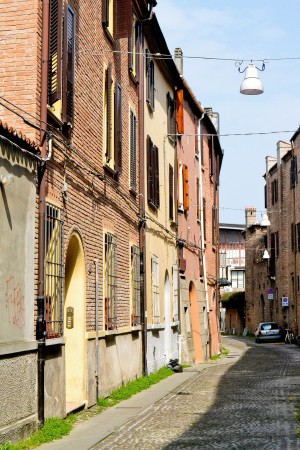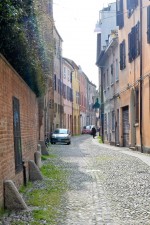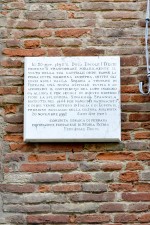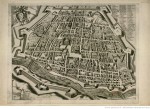Via Centoversuri
Among the oldest streets in the city, Via Centoversuri is the site of the first Jewish settlements, in the 13th century.
1. An ancient road
It is one of the oldest roads, near that "Via Grande" that ran along the Po (now Via Ripagrande), a commercial axis of excellence of the "linear city" that developed on the bank of the river. The area, decentralized with respect to the heart of Ferrara, which is growing around the squares of the Cathedral and the Municipality, is ideal for trade thanks to the river ports of San Nicolò and San Michele. There is confirmation of a rather compact and continuous Jewish settlement in this area from a story that momentarily distances the Este from the city. In 1293 Obizzo II d'Este died without leaving any heirs and the city authorities, to quell the resentments between his sons, proclaimed Obizzo's eldest son Azzo VIII (1263-1308) lord of Ferrara, Modena and Reggio, the death having sparked a conflict over the succession between the claimants to the government. In the clash between the armies that supported the rivals, the papal one in support of Francesco di Obizzo II prevailed, which brought the Ferrarese back under the direct rule of the State of the Church (of which it was a fief) and the consequent concession of the vicariate of Ferrara to the king of Naples Roberto d 'Angiò, whose garrison of Catalan mercenary soldiers remained stationed in the Castel Tedaldo from 1309 to 1317. In 1310 the papal government obliged adult men from Ferrara to swear allegiance to the Holy See: in the document of the so-called ‘oath of allegiance’ it is noted the presence of sixteen Jewish heads of household residing in the district (as the streets were called) of Centoversuri and one resident in the nearby district of Boccacanale.
2. The road
According to Gerolamo Melchiorri (1918), there are two hypotheses about the name of the street. The first, doubtful, derives its name from "Centro dei Vassuri", with reference to Goffredo, Baldissera and Vittorio Vassuri who may have lived in the street since 1254, who had testified in the case of religion concluded in 1301 against the heretic Cathar Armanno Pungilupo. The second hypothesis, according to the engineer Filippo Borgatti, is the derivation from 'versurus,' future of the Latin verb vertere, which means turning (in the sense of curve or curve), hence the name of "Centum-versuri", or winding road, with one hundred curves. According to Dino Tebaldi (1991) the toponym perhaps refers to the "subdivision of soils, after reclamation operations; and the allocation of plots to those who [...] had titles to work it. One can think of the early days of the Canossian lordship, when the Castel Tedaldo was built (in the village of Sopra) and the contiguous territory granted for use to the soldiers". The term ‘versuro’ means‘ plough ’
3. Quotes
"1295, 18 October, Ferrara - Arduino vicario and Iacobo, bishop's chamberlain, renew the investiture for emphyteusis to Bonavita, a Jewish son of Lazarinus, who acts as procurator of Allegra his mother, for himself, children and grandchildren or for himself and two successors, of a marriage of two and a half tables placed in the district of Centoversuri, for the annual fee of a ferrarino to be paid in March". (Franceschini 2007, regesto archive, doc. 34, from the Diocesan Historical Archive of Ferrara, p. 25)
"1314, 8 October, Ferrara - Brother Enrico da Campagnola, chamberlain of Brother Guido bishop of Ferrara, renews to Josep del fu Bonaluce, Jew, who receives for himself, children and grandchildren, or for two successors if at his death he will not have children or grandchildren, the investiture for emphyteuse of a farmhouse owned by the Ferrara Church located in the district of Centoversuri, at other assets of the investor, for the annual fee of a ferrarino in March...". (Franceschini 2007, regesto archive, doc. 52, from the Diocesan Historical Archive of Ferrara, p. 31)
"1317, 16 March - Iosep and Mazalia, Jews of Ferrara, declare that they must pay three ferrarini every year to the Episcopate of Ferrara for the annual pension of their farmhouses located in the district of Centoversuri... Mazalia, moreover, declares in the same way for Benasuta his niece for a farmhouse located in the same district and pays a ferrarino for the present year " (Franceschini 2007, regesto, doc. 54, from the Diocesan Historical Archive of Ferrara, p. 32). [The statement of both is repeated on 27 March 1318, ibid., doc. 55].
"1318, 27 March - Iosep Judeo, constituted before the episcopal chamberlain, declares to hold by right of level by the bishop and the Episcopate of Ferrara two houses in the Centoversuri district, for the annual fee of two bagatini, and for this year pays him four bagatini, committing himself to comply with what is required by law". (Franceschini 2007, regesto archive, doc. 56, from the Diocesan Historical Archive of Ferrara, p. 33)
Bibliography
- Fontana, Bartolommeo, Documenti vaticani di un plebiscito in Ferrara sul principio del sec. XIV, in «Atti e Memorie della Deputazione ferrarese di storia patria», s. I, 1, 1886
- Tebaldi, Dino, Ferrara. Le strade del silenzio, Giovanni Vicentini Editore, Ferrara 1991
- Franceschini, Adriano, Presenza ebraica a Ferrara. Testimonianze archivistiche fino al 1492, Olschki, Firenze 2007
- Melchiorri, Gerolamo, Bassi, Carlo, Nomenclatura ed etimologia delle piazze e strade di Ferrara. Ampliamenti all'opera di Gerolamo Melchiorri, 2G, Ferrara 2009
- Graziani Secchieri, Laura, Ebrei italiani, askenaziti e sefarditi a Ferrara: un’analisi topografica dell’insediamento e delle sue trasformazioni (secoli XIII-XVI), in Caffiero, Marina - Esposito, Anna (a cura di), Gli ebrei nello Stato della Chiesa Insediamenti e mobilità (secoli XIV-XVIII), Esedra editrice, Padova 2012, pp. 163-190 Vai al testo digitalizzato
Fototeca
Related Themes
Compiling entity
- Istituto di Storia Contemporanea di Ferrara
Author
- Edoardo Moretti
- Sharon Reichel




